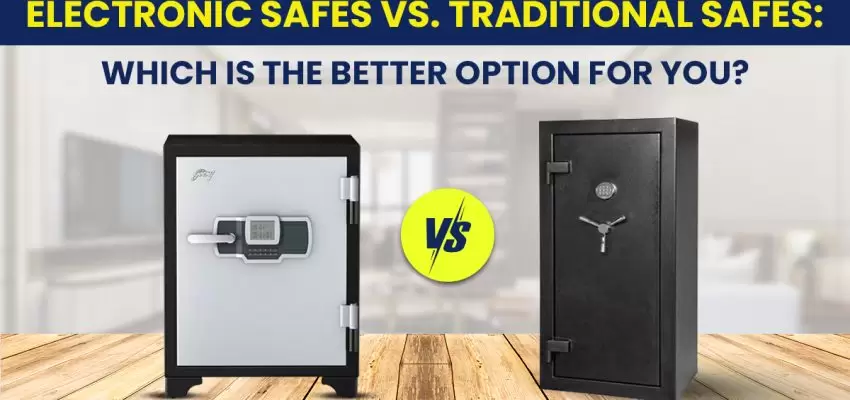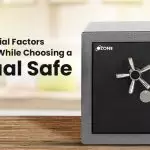The choice between manual and electronic safe locks is a continuous discussion, with each having particular advantages and disadvantages. While individual inclinations might be evident, taking into account the far-reaching benefits and impediments is crucial. Manual safes offer tried and true unwavering quality and cost-adequacy yet can be slow to open, not ideal for emergencies, etc. Whereas, electronic safes give quick access, high-level highlights, and usability but accompany a higher introductory expense and battery reliance. Only understanding the full picture can let people make informed choices.
Post your Requirement
Manual Safes
Manual safes, a customary and broadly seen model, guarantee secure capacity for resources and reports. With solid bodies and choices like mixed locks or manual bolts, they come in different sizes and tones. These dependable storage spaces offer full protection from both fire and burglary, making them a confided-in decision for homes and business spaces.
Advantages of Manual Safes
The main advantages of Manual Safes are:
- Reliability – Mechanical locks are time-tested. With regular servicing, they work consistently for years.
- Affordability – They tend to have a lower upfront cost compared to electronic locks. This makes them budget-friendly.
- Power-independent Operation – You don’t need batteries or electricity for them to work. This makes them suitable for areas with frequent power outages.
- Optional Key Locking – Some mechanical locks allow you to additionally secure the dial with a key. This prevents manipulation attempts.
Limitations of Manual Safes
Mechanical locks also come with some downsides:
- Slow To Open – Entering the combination precisely to open the lock can take time. Having to restart the process in case of errors can be inconvenient.
- Not Ideal For Emergencies – The slower unlocking process makes them less suited for situations requiring swift access like gun safes.
- Expert Help Needed – You may need to hire a professional locksmith if you want to change combinations or fix issues.
Types of Manual Safes
Here we have mentioned the two broad types of Manual Safes:
Combination Latch:
- A developed version of lock and key lockers opened with a numeric passcode.
- Available in various shapes, sizes, and colors.
- Features a display board with a knob for passcode input.
Lock and Key:
- Traditional safety locker for jewelry, used in homes and commercial areas.
- Comes in different sizes, shapes, and colors.
- Sturdy and fire-resistant with double walls, opened only with a key and bolt.
Electronic Safes
An electronic safe is a protected stockpiling gadget outfitted with computerized innovation. It replaces conventional locks with electronic frameworks, frequently including secret word safeguarded admittance. Accessible in different sizes and plans, electronic safes give a cutting-edge and helpful method for shielding resources and significant reports from burglary or unapproved access.
Benefits of Electronic Safes
The main upsides of Electronic Safes include:
- Speedy Entry – Options like fingerprint recognition allow very fast unlocking compared to dialing combinations mechanically.
- Customizable Codes – Users can set and update access codes on their own without needing to call a locksmith.
- Advanced Features – Electronic locks offer extra security through dual authentication, time delays, duress alerts, etc.
- Visibility In Dark Areas – Some models have built-in lights to illuminate keypads in the dark.
- Backup Of Codes – The codes remain stored in the lock memory even without battery power.
Limitations of Electronic Safes
On the flip side, the limitations of electronic safes include:
- Dependency On Batteries – They require periodic battery replacement and monitoring to keep working.
- Higher Cost – The high-tech features generally translate into a higher purchase price.
- Code Troubles – Forgetting passwords can cause panic and hinder access when urgently needed.
Types of Electronic Locks
Below we have listed the types of Electronic safes:
Electrical Combination Latch:
- Frees you from the hassle of keys.
- Secured by a secret password, a combination of numbers.
- Operated through a digital board for convenience.
- Available in various sizes, designs, and colors.
Mechanical Combination Latch:
- Functions similarly to the electrical combination latch.
- Opens with a mechanical passcode input.
- Lacks digital switches or keys.
- Comes in diverse designs, sizes, and colors.
Biometric Latch:
- Mainly used for commercial purposes.
- Requires fingerprints or saved biometric data for access.
- Among the most secure latch options available.
- Available in a variety of colors and sizes.
Conclusion
Basically, mechanical locks exemplify custom, offering immortal dependability, while electronic locks embrace present-day accommodation through innovation. While picking between the two, consider factors, for example, spending plan, utilization examples, and security chances. Mechanical locks are pragmatic and persevering, while electronic partners give progressed highlights. Surveying these perspectives guarantees a very educated choice, adjusting the picked safe lockers to explicit requirements and inclinations.
FAQs
Q-1. What distinguishes electronic safes from manual ones?
A-1. Electronic safes include advanced locks, killing the requirement for keys. They offer secret word security and various shapes, sizes, and works.
Q-2. Are electronic safes secure for home use?
A-2. Indeed, computerized storage spaces furnish high-security levels with secret phrase safeguarded admittance, defending assets against burglary.
Q-3. Are electronic safes susceptible to hacking or unapproved access?
A-3. Electronic safes accompany progressed security features, however, it’s critical to pick respectable brands with strong encryption to limit the gamble of hacking.
Q-4. What occurs if the battery of my electronic safe dies?
A-4. Electronic safes frequently incorporate low battery markers. In case of battery disappointment, the stored codes remain intact. Replacing the battery is normally a simple process through the keypad, guaranteeing that your stored data is protected without compromising security.























Post A Comment